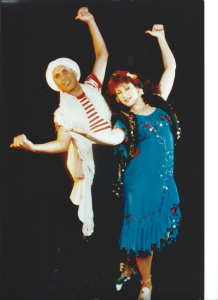 Iskandarani / Bomboutiya
Iskandarani / Bomboutiya
Sailor/Fisherman dances have been discovered in many parts of the world. It is said that because of the English colonization in Egypt, this is where the English have adapted this style of dance to later on make it their own style e.g., Hornpipe. In Egypt, two known styles of this dance are the Iskandarani (from Alexandria, also called Eskandarani) and the Bomboutiya (from Port Said). (read more)
Saidi
The Saidi dance is originally from Upper Egypt between Gizeh and Edfu (Sa’id). The Saidi can be danced by both men and women. A Saidi dance can start out with an improvisation where the dancer uses his stick(s) to “act” out or show his skill in how he handles them. Once the music picks up, the Saidi dance can be very lively, energetic and earthy. Tahtib originated in Upper Egypt or the Sa’id , which is in the southern part of Egypt. (read more)
 Khaleeji
Khaleeji
This typical women’s dance comes from the Gulf Region, (e.g., Persian Gulf/Arabian Peninsula, Saudi Arabia, Kuwait, Bahrain, Oman, Qatar (United Arab Emirates). Because this dance comes from the Arabic gulf region, the khaleej, explains why it is often called khaleeji but it is not the only dance they have for this region. The locals in the Emirates call it raks na’ashat to distinguish the women’s dance from the various men’s dances. In Kuwait it can be referred to as Samra/Samri and in Saudi Arabia it can be referred to as Saudi. It is said that this dance was “imported”. There are also a variety of dance forms in the Khaleej mostly performed by men (some with a variety of weapons). (read more)

Beledi
Belonging to folklore, Beledi or Raks Beledi is a basic, earthy, traditional Egyptian style of women’s dance. The word Beledi translated simply means “of the country” or “of the town”. Beledi is the populaire or Shaabi of the Egyptians. Finger cymbals are sometimes used as well as a stick (cane). Today it can be fused with Egyptian Pop for a more modern, fun version of today’s generation, giving it both traditional and modern elements that create a new style and look. (read more)
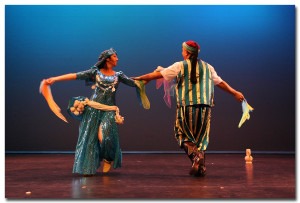 Tunisian Fezzani
Tunisian Fezzani
Raks Fezzani is one of main traditional Tunisian folkloric dances. It is also referred to as Raks Sharbia (Pot/Jar Dance). Fezzani style is originally from Fezan, Libya and you can see the strong connection between Fezzani and the Hagalla as they share some of the same strong hip twists. In Fezzani however, these strong hip twists are executed while sometimes balancing a Sharbia (Jar) on the head. (read more)
Tunisian Beldi
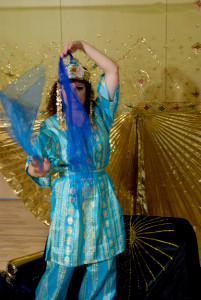
Beldi is a style of Tunisian dance found mainly in the big cities e.g., the capital of Tunis. The women are called Beldiya or Beldiyat (pl.). Beldi is sometimes called dance of the Moresque/Andalus. Beldi consists of smaller steps and movements that are not as big or exaggerated like that of the Tunisian Fezzani. Sometimes two small scarves are used to accompany the movements. The costume for this style of dance is a typical Tunisian Jalabia or sometimes called Jallaba. Today a more modern style can be worn such as a tunic with matching pants made of melia fabric. The melia costume worn mainly by the Bedouin for Fezzani is not worn for this style as the smaller movements would not be seen. (read more)
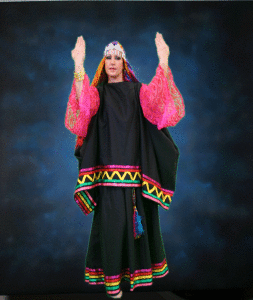 Choui
Choui
Every year in springtime the Chaoui Berber celebrate in the region of Arris (Atlas Mountain Aures) a fertility fest called Bendou and during this fest, the young girls dance Abdaoui. This dance is based on a historical legend: A long time ago there lived a very generous old man and he owned one fig tree and he allowed everyone that came there to decorate this tree. After he died, they claimed him as a holy man and buried him beneath this tree. Each year they honored him as a Marabou (Saint). The village people remembered and honored him every spring when nature gives its fruit. (read more)
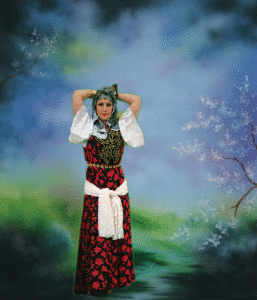 Zindali
Zindali
Zindali has a rhythm and dance style typically found in Northeast Algerian (Constantine, Annaba, Batna, Souk Ahras and (Northwest Tunisia).
This dance improvisation is performed by women and the important value of movement concentrated with movement of the stomach. (Like the dance of Oranaise “Oran”) The symbolization in this dance is the dropping of the egg before menstruation (period). (read more)
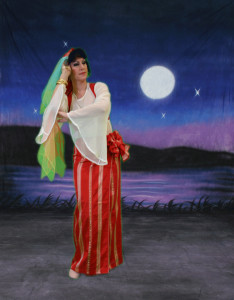 Algerwah
Algerwah
In North Africa, the Andalou dance has different styles depending on location and where they came from. For example, in Tunisia the influence comes from Seville, in Algeria the influence comes from Cordoba and Morocco, the influence comes from Grenada and Valencia. These dances are considered renaissance dances.
Algerwah is mainly found in Algiers, the capitol of Algeria. As with many North African Andalusian dances, it is a soft dance without heavy accents. Often small scarves are used and the arms and scarves have a floating effect as the hips move and sway from side to side. (read more)
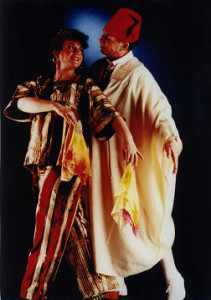 Bounaouara
Bounaouara
Bounaouara is a style of Tunisian folkloric dance that is performed by both women and men. Bouanaouara translated means “with the flower”. (read more)
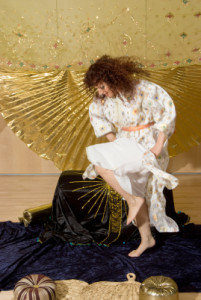 Moroccan Sha’abi
Moroccan Sha’abi
There are many different styles of folk dance found in Morocco. Shaa’bi (means “from the folk”, and can be found in just about every city, town or village with a variation in style. In Marrakech we find the Marrakchi (which means from Marrakech). In the typical Marrakech style, they use footwork called “rekza” or “rakza” (Daqa “foot knocking with heel or flat” or Bajah) as well as hand clapping patterns. This dance for the Moroccans is like Beledi to the Egyptians, Fezzani to the Tunisians and Zindali for the Algerians. (read more)
